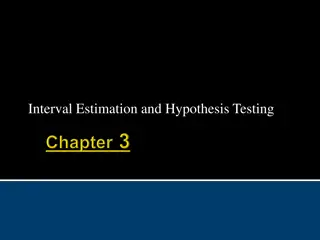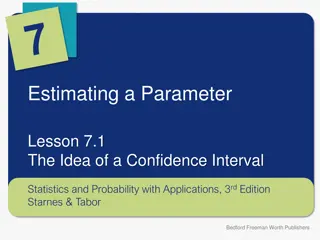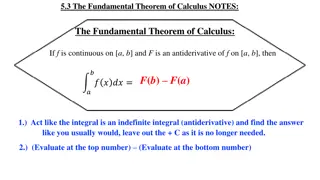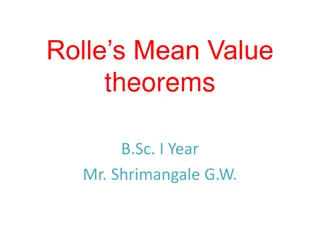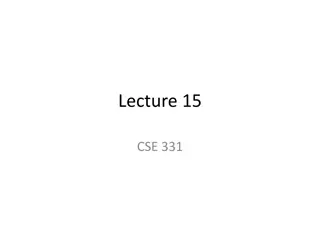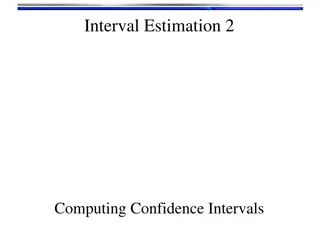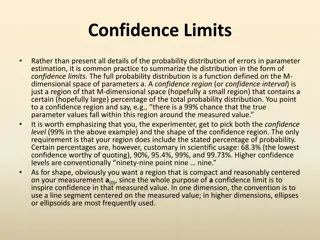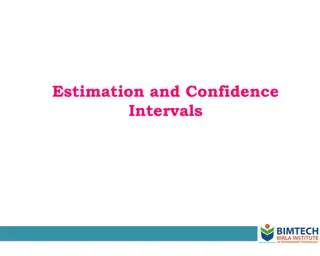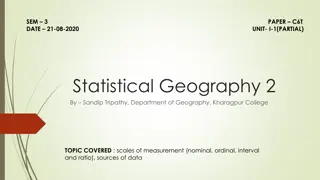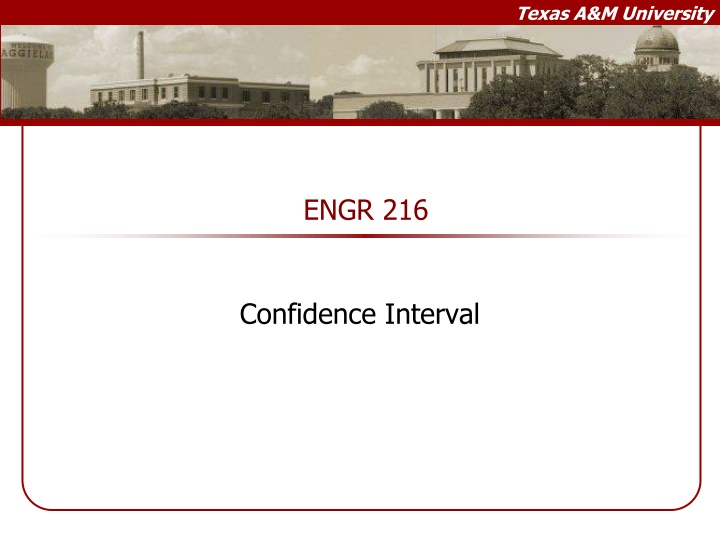
Confidence Intervals and the Central Limit Theorem
Explore the Central Limit Theorem and understand how to construct confidence intervals using Z-table calculations. Discover the importance of studying confidence intervals in estimating averages and sample means. Dive into the workings of the CLT and learn about its applications in statistical analysis.
Download Presentation

Please find below an Image/Link to download the presentation.
The content on the website is provided AS IS for your information and personal use only. It may not be sold, licensed, or shared on other websites without obtaining consent from the author. If you encounter any issues during the download, it is possible that the publisher has removed the file from their server.
You are allowed to download the files provided on this website for personal or commercial use, subject to the condition that they are used lawfully. All files are the property of their respective owners.
The content on the website is provided AS IS for your information and personal use only. It may not be sold, licensed, or shared on other websites without obtaining consent from the author.
E N D
Presentation Transcript
Texas A&M University ENGR 216 Confidence Interval
Learning Objectives Understand the outcomes of the Central Limit Theorem Understand and learn to construct a Confidence Interval Use Z-table calculations to compute a Confidence Interval 2
Why Study Confidence Interval? What is the best estimate for the average power consumption or life of a bulb? 3
Central Limit Theorem (CLT) Source: http://wise1.cgu.edu/cltmod/reviewclt.asp (this link will take to you a nice tutorial) Describes distribution of possible sample means Given a random sample of size N from a population whose mean is x, and standard deviation is x : - The distribution (think histogram) of the mean of the sample: 1) has a mean equal to the population mean x: 2) has a standard deviation (aka standard error or standard error of the mean) equal to the population standard deviation, x, divided by the square root of the sample size, N: 3) the shape of the sampling distribution of the mean approaches normal as N increases, regardless of the shape of the population distribution. 4
A few caveats The CLT allows us to determine the likely accuracy of a sample mean, but only if the sampling distribution of the mean is approximately normal. If population distribution is normal: sampling distribution of the mean will be normal for any sample size, N (even N = 1). If population distribution is not normal, has a bump in the middle, no extreme scores, and no strong skew: sampling distribution of the mean will be very close to normal for a a sample of modest size (e.g., N = 30) If the population distribution is far from normal (e.g., extreme outliers or strong skew): to produce a sampling distribution of the mean that is close to normal a very large sample may be needed(e.g., N = 500 or more). Important note: You should not assume that the sampling distribution of the mean is normal without considering the shape of the population distribution and the size of your sample. A sample with N > 30 does not guarantee a normal sampling distribution if the population distribution is far from normal. 5
Example On eCampus there is a file ClassData.csv. Code to load it and plot a histogram of the data is given below (try it yourself): Distribution of the Population: import csv import matplotlib.pyplot as plt import numpy as np with open('c:\work\Class6Data.csv') as csv_file: csv_reader = csv.reader(csv_file, delimiter = ',') data = [] for row in csv_reader: data.append(float(row[0])) # now make a histogram npData = np.asarray(data) histCount, bin_edges = np.histogram(npData) print(histCount) n, bins, patches = plt.hist(x=npData) plt.xlabel('data value') plt.ylabel('Frequency') plt.show()
Illustration of CTL Now let s write Python code that will: 1. Creates an array of k random values from the data set 2. Computes the average of this sample, and appends this mean to a list 3. Repeats this 200 times 4. After we have 200 sample means, create a histogram of the sample means
Some more code for you to try (one script in two columns) import csv import matplotlib.pyplot as plt import numpy as np from random import randint from statistics import mean for i in range(200): x = [] for j in range(k): n = randint(0,m-1) x.append(data[n]) means.append(mean(x)) with open('c:\work\Class6Data.csv') as csv_file: csv_reader = csv.reader(csv_file, delimiter = ',') data = [] for row in csv_reader: data.append(float(row[0])) n, bins, patches = plt.hist(x=means, bins = 20) plt.xlabel('sample mean value') plt.ylabel('Frequency') titleString = 'k = '+ str(k) plt.title(titleString) plt.show() # we will need the size of the data list later m = len(data) # now select k random values from the data and calculate their mean # repeat this 200 times k = 10 means = []
Two new functions from random import randint Gives us a random integer between the two values in its parentheses from statistics import mean Gives us the average of the values in its parentheses Note that the results will be slightly different every time you run this program, because the random values will be different Let s run our program with different values of k and see what impact the sample size has on the sample distribution of the mean
Going back to the original question, how do you get a better estimate of the population mean ? 12
Confidence Interval (CI) Here is the scenario: We know the variance, ?2 (or standard deviation, ?) of a population However, we don t know the mean of the population (?) Our job is to estimate (1) an interval and (2) a confidence level that the interval contains the true population mean. We use a sample mean ( ?) and the size of the sample (?) to calculate the two values that define the interval 13
Confidence Interval (CI) The Need: Point estimate does not provide enough information about a parameter Usually, we prefer to have an interval in which we would expect to find the true mean. This interval is called Confidence Interval (CI). Lis the lower confidence limit and U is the upper confidence limit We would say, for example, that we are 95% confident that the interval between L and U contains thetrue mean 14
Consider the distribution of the mean of the sample: For a large enough sample size, we know the distribution of the sample mean is approximately normal with mean ? ?= ? and standard deviation ? ?= ? ?. 15
Consider the distribution of the mean of the sample: 0.25 0.2 p 0.15 f(z) 0.1 0.05 0 xL xU 0 We want to construct an interval [xL xU] such that the probability of the sample mean ? lying in this interval (centered around the true population mean ) is p. 16
Consider the distribution of the mean of the sample: 0.25 0.2 p 0.15 f(z) 0.1 0.05 0 If the area in red region is p, how much is left in the tail regions? = 1 - p 17
We want to construct an interval [xL xU] such that the probability of the sample mean ? lying in this interval (centered around the true population mean ) is p. Now let us convert this statement into an equation. P(xL < x < xU) = p = 1 - 18
Now convert to z variable Standard Normal Distribution 0.25 0.2 0.15 f(z) 0.1 0.05 0 zL zU 0 19
Express everything in terms of alpha (?) We want to construct the confidence interval centered on the mean so that the probability that zL < z < zUis p The total area in white under the standard normal curve is ?. 0.25 0.2 0.15 f(z) 0.1 0.05 0 ??= ? ??= ? 0 ? 2 ? 2 20
Remember the distribution is symmetric 0.25 0.2 0.15 f(z) 0.1 0.05 0 0 ??= ? ??= ? ? 2 ? 2 |??| = ?? = ? 21
Putting it all together ? ??< ? < ?? = ? Convert to z variable and put it in terms of alpha ?? ? ? ? ? ? ?<?? ? ? ? ?< = 1 ? ? Putting it in terms of z ? ? ? ? < ?< ? = 1 ? ? Re-arrange and after a little bit of algebra ? ? ? ?< ? < ? + ? ? ? = 1 ? = ? ? 22
? ?? ?< ? < ? + ? ? ? = 1 ? = ? ? 23
Example Calculation For a 95% confidence interval, we want to find ? so that the probability that z is in the interval (- ? , ? ) is 0.95 0.25 0.2 0.15 f(z) 0.1 0.05 0 -? ? 0 Recall how we used the z-values and the standard normal table to determine probabilities 24
Find the z-value The area between 0 and ? is 0.5 0.025 = 0.475 So in this case, ? = 1.96 25
Confidence interval of ? with known ? If ? is the mean of a random sample of size N from a population with known variance ?2, a 100? % confidence interval for ? is given by ? ? ? ?< ? < ? + ? ? ? where ? is the ?-value that gives you the 100p % probability Walpole, Ronald E. et al. Probability & Statistics for Engineers & Scientists, 8th ed. Pearson Prentice Hall: Upper Saddle River, NJ, 2007, p. 275. 26
Confidence Interval Example 1 A soft-drink machine is regulated so that the amount of drink dispensed is approximately normally distributed with standard deviation equal to 0.15 deciliter. Find a 95 % confidence level for the mean of all drinks dispensed by this machine if a random sample of 36 drinks has an average content of 2.25 deciliters. 27
Confidence Interval Example 1 A soft-drink machine is regulated so that the amount of drink dispensed is approximately normally distributed with standard deviation equal to 0.15 deciliter. Find a 95 % confidence level for the mean of all drinks dispensed by this machine if a random sample of 36 drinks has an average content of 2.25 deciliters. ? = 2.25 ? = 0.15 ? = 36 p = 0.95 What z-value do we need? 28
Confidence Interval Example 1 A soft-drink machine is regulated so that the amount of drink dispensed is approximately normally distributed with standard deviation equal to 0.15 deciliter. Find a 95 % confidence level for the mean of all drinks dispensed by this machine if a random sample of 36 drinks has an average content of 2.25 deciliters. ? ? ? ?< ? < ? + ? ? 36< ? < 2.25 + 1.960.15 ? = 2.25 ? = 0.15 ? = 36 ? = 0.95 ? 2.25 1.960.15 36 2.20 < ? < 2.30 29
Confidence Interval Example 2 A soft-drink machine is regulated so that the amount of drink dispensed is approximately normally distributed with standard deviation equal to 0.15 deciliter. Find a 90 % confidence level for the mean of all drinks dispensed by this machine if a random sample of 36 drinks has an average content of 2.25 deciliters. What is different? How do you handle it? What difference does it make in the resulting interval? 30
Confidence Interval Example 3 An electrical firm manufactures light bulbs that have a length of life that is approximately normally distributed with a standard deviation of 40 hours. If a sample of 30 bulbs has a an average life of 780 hours, find a 96% confidence interval for the population mean of all bulbs produced by this firm. 31


